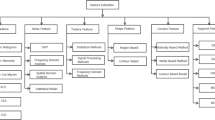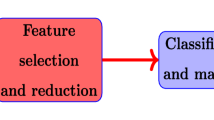Abstract
Fingerprint spoofing is a method of bypassing the security of a biometric fingerprint system by using artificial fingerprints created with various materials and techniques. Numerous enhancement technologies are available to improve the quality of the spoof-free fingerprint image. Existing technology requires more processing time for terrible ridge and valley; significant security challenges for authenticating a legal person. The paper proposes a novel Fingerprint Enhancement, object area detection, and Gabor-based ridge era (FEOG) model to enhance the spoof-free fingerprint image. The new method includes morphological finger item vicinity reputation, a normalization process, and Gabor-based ridge enhancement for higher enhancement for better authentication. Our proposed method outperforms the SH-DB-MOL database when tested with various metrics.
.













Similar content being viewed by others
References
Khan TM, Khan MAU, Kong Y (2014) Fingerprint image enhancement using multi-scale DDFB based diffusion filters and modified Hong filters. Elsevier, Amsterdam, pp 4206–4214
Yun E, Cho S (2006) Adaptive fingerprint image enhancement with fingerprint image quality analysis. Image Vis Comput 24(1):101–110
Ogbuokiri BO, Agu M (2015) An enhanced authentication system using face and fingerprint technologies. IOSR J Comput Eng 17(6):74–84
Senthil Selvi A, Kumar KPM, Dhanasekeran S, Maheswari PU, Ramesh S, Pandi SS (2020) De-noising of images from salt and pepper noise using hybrid filter, fuzzy logic noise detector and genetic optimization algorithm (HFGOA). Multimed Tools Appl 79(5–6):4115–4131
Qi Y et al (2022) A comprehensive overview of image enhancement techniques. Arch Comput Methods Eng 29(1):583–607. https://doi.org/10.1007/s11831-021-09587-6
Gupta R, Khari M, Gupta D, Crespo RG (2020) Fingerprint image enhancement and reconstruction using the orientation and phase reconstruction. Information science (New York). Elsevier, Amsterdam, pp 201–218
Ali SF, Khan MA, Aslam AS (2021) Fingerprint matching, spoof and liveness detection: classification and literature review. Front Comput Sci. https://doi.org/10.1007/s11704-020-9236-4
Hong L, Wan Y, Jain A (1998) Fingerprint image enhancement: algorithm and performance evaluation. IEEE Trans Pattern Anal Mach Intell 20(8):777–789
Deshpande UU, Malemath VS, Patil SM, Chaugule SV (2022) Automatic latent fingerprint identification system using scale and rotation invariant minutiae features. Int J Inf Technol 14(2):1025–1039. https://doi.org/10.1007/s41870-020-00508-7
Lee CS, Kuo YH, Yu PT (1997) Weighted fuzzy mean filters for image processing. Fuzzy Sets Syst 89(2):157–180
Pankanti S, Prabhakar S, Jain AK (2002) On the individuality of fingerprints. IEEE Trans Pattern Anal Mach Intell 24(8):1010–1025
Farbiz F, Menhaj MB, Motamedi SA, Hagan MT (2000) A new fuzzy logic filter for image enhancement. IEEE Trans Syst Man Cybern Part B Cybern 30(1):110–119
Liu Q, He Y (2020) Robust Geman-McClure Based nonlinear spline adaptive filter against impulsive noise. IEEE Access 8:22571–22580. https://doi.org/10.1109/ACCESS.2020.2969219
Wang S, Wang Y (2004) Fingerprint enhancement in the singular point area. IEEE Signal Process Lett 11(1):16–19
Hasan H, Abdul-Kareem S (2013) Fingerprint image enhancement and recognition algorithms: a survey. Neural Comput Appl 23(6):1605–1610
Clausi DA, Deng H (2005) Design-based texture feature fusion using Gabor filters and co-occurrence probabilities. IEEE Trans Image Process 14(17):925–936
Chen C, Chen DC (1996) Multi-resolution Gabor filter in texture analysis. Pattern Recognit Lett 17(10):1069–1076
Mehrotra R, Namuduri KR, Ranganathan N (1992) Gabor filter-based edge detection. Pattern Recognit 25(12):1479–1494
Kumar M, Priyanka (2019) Various image enhancement and matching techniques used for fingerprint recognition system. Int J Inf Technol 11(4):767–772. https://doi.org/10.1007/s41870-017-0061-4
Farooq H, Naaz S (2020) Performance analysis of biometric recognition system based on palmprint. Int J Inf Technol 12(4):1281–1289. https://doi.org/10.1007/s41870-018-0230-0
Fu B, Zhao X, Song C, Li X, Wang X (2019) A salt and pepper noise image denoising method based on the generative classification. Multimed Tools Appl 78(9):12043–12053
Gangonda SS, Patavardhan PP, Karande KJ (2022) VGHN: variations aware geometric moments and histogram features normalization for robust uncontrolled face recognition. Int J Inf Technol 14(4):1823–1834. https://doi.org/10.1007/s41870-021-00703-0
Khan TM, Bailey DG, Mohammad A, Khan U, Kong Y (2017) Efficient hardware implementation for fingerprint image enhancement using anisotropic Gaussian filter. IEEE Trans Image Process 14(8):2116–2126
Yang J, Liu L, Jiang T, Fan Y (2003) A modified Gabor filter design method for fingerprint image enhancement. Pattern Recogn Lett 24(12):1805–1817
Arun R, Nair MS, Vrinthavani R, Tatavarti R (2011) An alpha rooting based hybrid technique for image enhancement. Eng Lett 19(3):159–168
Sankaran A, Vatsa M, Singh R (2015) Multisensor optical and latent fingerprint database. IEEE Access 3:653–665. https://doi.org/10.1109/ACCESS.2015.2428631
Jain AK, Feng J (2011) Latent fingerprint matching. IEEE Trans 33(1):88–100
Pilevar AH, Saien S, Khandel M, Mansoori B (2015) A new filter to remove salt and pepper noise in color images. Signal Image Video Process 9(4):779–786
Bai T, Tan J (2015) Automatic detection and removal of high-density impulse noises. IET Image Process 9(2):162–172
Lin PH, Chen BH, Cheng FC, Huang SC (2016) A morphological mean filter for impulse noise removal. J Disp Technol 12(4):344–350
Bhadouria VS, Ghoshal D (2016) A study on genetic expression programming-based approach for impulse noise reduction in images. Signal Image Video Process 10(3):575–584
Faragallah OS, Ibrahem HM (2016) Adaptive switching weighted median filter framework for suppressing salt-and-pepper noise. AEU-Int J Electron Commun 70(8):1034–1040
Arora S, Bhatia MPS (2020) Fingerprint spoofing detection to improve customer security in mobilefinancial applications using deep learning. Arab J Sci Eng 45(4):2847–2863
Chugh T, Jain AK (2021) Fingerprint spoof detector generalization. IEEE Trans Inf Forensics Secur 16:42–55
Fei J, Xia Z, Yu P, Xiao F (2020) Adversarial attacks on fingerprint liveness detection. Eurasip J Image Video Process 2020(1):1–11
Chen J, Zhan Y, Cao H, Wu X (2018) Adaptive probability filter for removing salt and pepper noise. IET Image Proc 12(6):863–871
Erkan U, Thanh DNH, Hieu LM, Enginoglu S (2019) An iterative mean filter for image denoising. IEEE Access 7:167847–167859
Acknowledgements
I would like to acknowledge and express my heartfelt gratitude to my supervisor who assisted me in writing this research paper with valuable ideas. His guidance and advice were extremely helpful in completing this research paper at all levels. I'd also like to express my heartfelt gratitude to my entire family for their unending assistance and knowledge when assigning my studies and to write my paper. Your prayer for me has been what has kept me going this far. As a result, I’d like to thank God for allowing me to go through all of this. Every day, I've improved my steering. I can continue to put my faith in you for my future.
Author information
Authors and Affiliations
Corresponding author
Rights and permissions
Springer Nature or its licensor (e.g. a society or other partner) holds exclusive rights to this article under a publishing agreement with the author(s) or other rightsholder(s); author self-archiving of the accepted manuscript version of this article is solely governed by the terms of such publishing agreement and applicable law.
About this article
Cite this article
Khan, H.M., Venkadesh, P. Spoofing free fingerprint image enhancement. Int. j. inf. tecnol. 15, 477–485 (2023). https://doi.org/10.1007/s41870-022-01129-y
Received:
Accepted:
Published:
Issue Date:
DOI: https://doi.org/10.1007/s41870-022-01129-y




